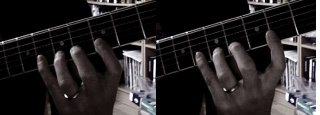playing in position pt. 6: more physiological compromises
If you’re relaxed and comfortable with the tasks covered in the last entry on position playing, you should be secure with the shape colloquially known as ‘finger-per-fret’. Although this hand shape is fine up to a point, if you tune your guitar intervals larger than major thirds, and that’s the case with all but one adjacent pair of strings in standard tuning, then the whole chromatic scale is not available in a single position. In order to cover the chromatic scale, we need four fingers to span five fret positions. Above, left is the shape we’ve covered so far, as above, right is the extended shape (I’ve heard this referred to as ‘extended-finger-per-fret’ which sounds to me like a klugy designation at best). From now on, the bulk of our position playing will be shared between these two hand shapes; shifting from one shape to the other.
Above, left is the shape we’ve covered so far, as above, right is the extended shape (I’ve heard this referred to as ‘extended-finger-per-fret’ which sounds to me like a klugy designation at best). From now on, the bulk of our position playing will be shared between these two hand shapes; shifting from one shape to the other.
A question you may be asking is, conceptually, do you (a) shift the first finger while keeping the rest of your hand stationary, or do you (b) shift your hand while keeping your first finger stationary. Since you’d be only moving one finger (a) seems to be more efficient, on the other hand, given that you should be getting your bearing from your first finger, (b) seems more in line with the reasons for playing in position. The image below shows the ‘finger-per-fret’ shape in the center, with movements (a) and (b) represented on the left and right respectively: The simple answer to this query is both (a) and (b); the more complex answer is neither (a) nor (b).
The simple answer to this query is both (a) and (b); the more complex answer is neither (a) nor (b).
Simple answer first: When shifting up or down the neck, you still get your bearings from your first finger, thus, in such situations, (b) describes better the mental processes involved. However, once you have shifted into position, (a) describes better the processes involved since the first finger may occupy two fret positions. Let’s illustrate this with two ways to approach a scale fragment: The first of these, you’d be thinking in terms of a single position in which the first finger occupies two fret positions—thus (a). In the second example, as you shift up the neck of the instrument, you’d be getting your bearings from the first finger, and be thinking in terms of two positions with two corresponding hand shapes—thus (b).
The first of these, you’d be thinking in terms of a single position in which the first finger occupies two fret positions—thus (a). In the second example, as you shift up the neck of the instrument, you’d be getting your bearings from the first finger, and be thinking in terms of two positions with two corresponding hand shapes—thus (b).
Now the more complex answer: Eventually, you should not be thinking about macroscopic gestures (the position and movement of the first finger/arm/etc), and the microscopic gestures (the shape and orientation of your finger/hand/etc) as separate phenomena with corresponding independent mental processes. This should come with study, time and practice.
Incidentally, some of you may know of a technique in which the fourth finger occupies two fret positions (in which case a single position spans six fret positions). I am not going to cover that here primarily because I don’t use this fourth finger extension at all frequently, and thus I feel unqualified to talk about it.


No comments:
Post a Comment